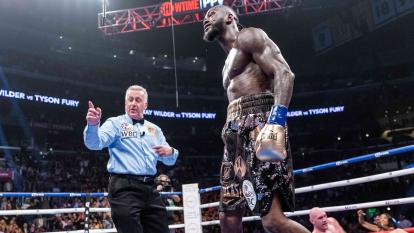By Caryn A. Tate
Want to understand refereeing and scoring fights? Here is everything you need to know, based on an official three-day certification course.
If you’ve watched boxing in the past 20 years, you’ve undoubtedly seen Jack Reiss and Patrick Russell at work. Reiss and Russell have refereed many major bouts in recent memory and judged several others. With their combined 62 years in the sport, one would be hard pressed to find a duo more knowledgeable about boxing officiating.
Reiss and Russell recently lent their decades of experience to teaching a three-day certification course in Vancouver, British Columbia for prospective boxing officials. Reiss also teaches courses for the ABC (Association of Boxing Commissions) on occasion. Here are some key points from the course:
JUDGING
“It’s vital a judge be unbiased and not give more credit to a more popular or flashy fighter, or to a fighting style that the judge may personally prefer,” Pat Russell said. “It all comes down to the criteria.”
As he explained, the official rules of the ABC, which developed the Unified Rules of Boxing followed by most commissions, state that there are four specific criteria that should be utilized when scoring a round:
Clean punching (power versus quantity)
Effective aggressiveness
Ring generalship
Defense
Note the order. Contrary to popular belief, the four scoring criteria are not supposed to be lumped together and applied at once. Russell stressed the order of importance: first and foremost, the number and effect of clean punches should be used to gauge the winner of a round. If the fighters are relatively even in that regard, that’s when the judge should go to the next criterion, effective aggressiveness, to determine which boxer is doing better in that area. And so on.
The first and primary scoring criterion, clean punching, refers to number but also the quality of the punches. Russell stated, “Effective punches have damaging effect.”
In general, effectiveness is more important than volume. However, if, for example, a smaller fighter is landing so much that he’s keeping his larger opponent’s hands at home more of the time, this means the smaller fighter took away the effectiveness of the bigger boxer’s heavier punches. The judge has to then weigh which had greater effect (the smaller fighter’s quantity or the larger fighter’s more damaging punches).
Russell is clear about the meaning of “effective aggressiveness.” It isn’t simply the fighter who is moving forward. As he put it, “Walking a guy down doesn’t mean you’re effective.”
An effectively aggressive fighter thwarts and frustrates the opponent from executing his own game plan. Conversely, if the other fighter makes the aggressive boxer miss and lands his own punches, he/she is now the more effective fighter.
“A fighter is a ring general by using the ring to his advantage…by owning the ring and moving where he wants to move when he wants to,” said Russell.
In addition, Russell explained, “An effective defense nullifies two of the major, and more highly prioritized, criteria: clean punching and aggression. Effective defense can be very frustrating to an aggressive opponent, and that frustration can be interpreted as the defensive fighter being more effective under the scoring criteria.”
“ Safety is a referee’s number one priority. ”Referee Jack Reiss
It’s imperative that a judge treat each round as a standalone three-minute fight rather than carrying the memory of what happened in a prior round in the back of his mind. There are occasional rounds in boxing that are so close that the scoring can be somewhat subjective. But Russell clarified that typically, if a judge applies the scoring criteria properly and in order, it’s usually not a mystery how a round should be scored.
REFEREEING
Veteran referee Jack Reiss is one of the most consistent referees in the sport because he prepares by studying the boxers involved and develops protocols and procedures in advance.
One of the items Reiss stressed was the importance of a referee understanding infighting so that he is not unnecessarily breaking up the fighters. This generally occurs when a referee doesn’t understand the difference between holding and clinching.
“Holding is when a fighter stops and uses both hands to stop the other boxer’s ability to punch for no apparent reason,” Reiss said. “Clinching is an offensive technique used to navigate the ring and change position.”
If the boxers are tied up on one side but have hands free on the other side, Reiss will tell them, “Your hands are free! Work out of it!”
During the pre-fight instructions in the dressing rooms, Reiss explains this scenario to the fighters.
Reiss says that if a referee breaks the fighters too soon, it can change the course of a fight—particularly when you have a taller, longer fighter facing a shorter boxer who has to work his way inside to be effective.
“If the shorter fighter finally works his way inside, and the ref doesn’t understand infighting and breaks them…he just robbed the shorter fighter of the real estate he paid for.”
There’s a common school of thought in the sport that a low blow is anything at or below the belt line of the trunks. This is untrue and inconsistent as boxers wear their trunks at different levels. Some also think the dividing line is at the navel, which is no longer true either.
In fact, the ABC recently changed the rule to say that a low blow is a punch that lands below the hip line. If a punch lands on that line, it’s still legal; the shot has to land below the hip line to be low.
Reiss gauges the extent of a fighter’s sustained damage by determining whether the boxer is intelligently defending himself.
“If the fighter runs, holds, or takes a knee, I know he’s still thinking. If the fighter stands and fights, it tells me he’s operating on instinct.”
Determining whether to stop a fight on a boxer who has taken damage but is still fighting back can be tricky. Reiss keeps five questions in mind:
Can he mathematically win the fight?
Does he have a real puncher’s chance?
Does he really want to continue or is he fighting to survive?
Does he have visible physical damage?
What’s best for boxing?
“Safety is a referee’s number one priority,” Reiss stated. “We’re here to protect fighters from four things: Unnecessary harm; from the opponent if the fighter can no longer protect himself; from his corner; and from himself or herself.”
Article courtesy of PBC









Recent Comments